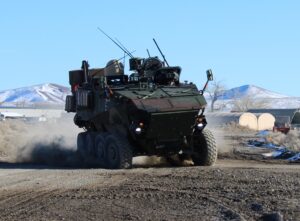The Marine Corps has officially awarded a pair of contracts to General Dynamics Land Systems [GD] and Textron Systems
[TXT] to build 30mm turreted versions of their Advanced Reconnaissance Vehicle (ARV-30) prototypes.
The two firms are each tasked with building one ARV-30 prototype, with the Marine Corps noting vehicle deliveries are expected in fiscal year 2025.

“The ARV-30 will provide greater capability than the current Light Armored Vehicle 25mm variant (LAV-25) and meet the Marine Corps’ requirements for Force Design 2030,” the Marine Corps said in a statement. “It will be equipped with advanced features such as an automatic 30mm medium-caliber cannon, anti-armor capability, modern command-and-control systems, and a full range of advanced sensors.”
Both GD Land Systems and Textron have built ARVs, integrated with C4/UAS payloads, for the current competitive prototyping program, with those platforms having undergone testing over the last year to help inform requirements for the Marine Corps’ effort to find a replacement for its legacy LAVs.
The Marine Corps is planning to release a Request for Proposals in the second quarter of FY ‘25 for ARV’s engineering and manufacturing development phase, a spokesperson for the Program Executive Office Land Systems recently told Defense Daily, before holding a full and open competition leading to an award in FY ‘26,
GD Land Systems officials recently detailed the slate of prototype testing and events from last year, while noting that further risk reduction efforts to inform ARV requirements were planned for this year. (Defense Daily, Jan. 19).
“Now, we’re building the second [ARV] prototype. We’re looking forward to showing it to the Marines and having it go through test and evaluation. And it will further inform requirements for the overall program,” Phil Skuta, GD Land Systems’ director of U.S. Marine Corps and Navy strategy and business development, told Defense Daily on Thursday.
The Marine Corps awarded GD Land Systems a $10.9 million deal and $11.8 million to Textron for the ARV-30 effort, according to a Feb. 29 DoD contracts announcement.
“Having developed, produced and tested two Cottonmouth ARV prototypes over the last several years, we look forward to continuing the same maturation on this next prototype variant and thereby supporting the U.S. Marine Corps’ evolution of the ARV requirements. The 30mm variant will allow for further evaluation, integration and risk reduction prior to entering the next phase of the program,” David Phillips, Textron’s senior vice president for land and sea systems, told Defense Daily.
Steve Myers, the Marine Corps’ program manager for light armored vehicles, said the ARV-30 will utilize the same turret and weapon system as the turreted version of BAE Systems’ Amphibious Combat Vehicle, the ACV-30.
“Ensuring commonality is crucial, especially for the Marine Corps’ capacity to maintain weapon systems with limited fleets. The prototyping of the ARV-30 allows the government to test and confirm the requirements before entering the Engineering and Manufacturing Development phase,” Myer said in a statement.
The ACV-30 utilizes Kongsberg’s unmanned RT-20 medium caliber turret for the ACV-30.
BAE Systems recently announced it has delivered the first production representative ACV-30 test vehicle to the Marine Corps (Defense Daily, Feb. 1).
BAE Systems had also been participating in a study to inform ARV requirements with a version of its ACV integrated with a suite of C4/UAS capabilities, while that effort formally concluded in late FY ‘23.
A PEO Land Systems spokesperson told Defense Daily recently the study helped the Marine Corps decide it would need a new purpose-built platform for ARV rather than a modified version of an existing vehicle, such as the ACV.
“The emerging ACV capability promises excellent ship-to-objective mobility for Marine Corps infantry; however, a fully amphibious ship-to-shore capable armored personnel carrier is not required, nor optimally designed, to meet ARV and mobile reconnaissance mission needs,” the spokesperson said.